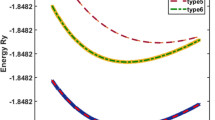Abstract
The theoretical status of empirical means (based on the heuristic Wyllie–Southwick and Krischer models) of the upper and lower Wiener bounds (i.e., the parallel and series model) for describing the effective thermal conductivity of multiphase materials is clarified, and other useful fit relations are recalled (geometric weighted mean) or newly proposed (generalized sigmoidal mean). All these relations, as well as the general power mean, are compared with the Hashin–Shtrikman bounds, and the admissible fit parameter ranges are determined for materials with isotropic microstructures. It is shown that weighted means result in curves with inflection points, but with different changes in curvature, whereas the curves of general power means do not exhibit inflection points at all. For materials with isotropic microstructure it is recommended to apply the fixed-parameter weighted means and sigmoidal means to Hashin–Shtrikman bounds instead of the Wiener bounds, as is common practice so far.






Similar content being viewed by others
References
O. Wiener, Abh. Math. Phys. Klasse Königl. Sächs. Ges. Wissensch. 32, 509 (1912).
Z. Hashin and S. Shtrikman, J. Appl. Phys. 33, 3125 (1962).
S. Torquato, Random Heterogeneous Materials—Microstructure and Macroscopic Properties (New York: Springer, 2002), pp. 403–646.
J.C. Maxwell, A Treatise on Electricity and Magnetism, vol. 1 (Clarendon Press, Oxford, 1873/reprint Dover, New York, 1954), pp. 435–449.
A. Eucken, Die Wärmeleitfähigkeit keramischer feuerfester Stoffe – ihre Berechnung aus der Wärmeleitfähigkeit der Bestandteile (Berlin: VDI Verlag, 1932), pp. 1–16.
D.A.G. Bruggeman, Ann. Phys. Leipz. 24, 636 (1935).
R. Landauer, J. Appl. Phys. 23, 779 (1952).
N. Phan-Thien and D.C. Pham, Int. J. Eng. Sci. 38, 73 (2000).
G. Tichá, W. Pabst, and D.S. Smith, J. Mater. Sci. 40, 5045 (2005).
W. Pabst and E. Gregorová, Mater. Sci. Technol. 31, 1801 (2015).
W. Pabst, T. Uhlířová, E. Gregorová, and A. Wiegmann, J. Eur. Ceram. Soc. 38, 2570 (2018).
T. Uhlířová, V. Nečina, and W. Pabst, J. Eur. Ceram. Soc. 38, 3004 (2018).
W. Pabst, T. Uhlířová, E. Gregorová, and A. Wiegmann, J. Eur. Ceram. Soc. 38, 2694 (2018).
W. Pabst, T. Uhlířová, E. Gregorová, and A. Wiegmann, J. Eur. Ceram. Soc. 38, 4026 (2018).
T. Uhlířová and W. Pabst, Scripta Mater. 159, 1 (2019).
T. Uhlířová and W. Pabst, Ceram. Int. 45, 954 (2019).
W. Pabst and E. Gregorová, Ceram. Silik. 48, 14 (2004).
S.C. Ji, Q. Wang, B. Xia, and D. Marcotte, J. Struct. Geol. 26, 1377 (2004).
S.C. Ji, Q. Gu, and B. Xia, J. Mater. Sci. 41, 1757 (2006).
O. Krischer, Die wissenschaftlichen Grundlagen der Trockentechnik (Berlin: Springer, 1963), pp. 223–232.
M.R.J. Wyllie and P.F. Southwick, J. Petrol. Technol. 6, 44 (1954).
I. Amara, A. Mazioud, I. Boulaoued, and A. Mhimid, Int. J. Heat Technol. 35, 576 (2017).
T. Renaud, P. Briery, J. Andrieu, and M. Laurent, J. Food Eng. 15, 83 (1992).
B. Dietrich, G. Schell, E.C. Bucharsky, R. Oberacker, M.J. Hoffmann, W. Schabel, M. Kind, and H. Martin, Int. J. Heat Mass Transf. 53, 196 (2010).
M.S. Rahman and X.D. Chen, Drying Technol. 13, 2153 (1995).
Z.B. Maroulis, M.K. Krokida, and M.S. Rahman, J. Food Eng. 52, 47 (2002).
N. Hamdani, J.K. Monteau, and A. Le Bail, Int. J. Refrig 26, 809 (2003).
J.F. Wang, J.K. Carson, M.F. North, and D.J. Cleland, Int. J. Heat Mass Transf. 49, 3075 (2006).
G.W. Milton, J. Appl. Phys. 52, 5294 (1981).
K.A. Lurie and A.V. Cherkaev, Proc. R. Soc. Edinb. 104A, 21 (1986).
J.K. Carson, J. Food Eng. 74, 430 (2006).
W. Woodside and J.H. Messmer, J. Appl. Phys. 32, 1688 (1961).
W. Woodside and J.H. Messmer, J. Appl. Phys. 32, 1699 (1961).
D.R. Chaudhary and R.C. Bhandari, Br. J. Appl. Phys. (J. Phys. D) 1, 815 (1968).
D.R. Chaudhary and R.C. Bhandari, Br. J. Appl. Phys. (J. Phys. D) 2, 609 (1969).
W. Pabst and E. Gregorová, J. Phys: Conf. Ser. 395, 012021 (2012).
Acknowledgements
This work is part of the project “Partially and fully sintered ceramics—processing, microstructure, properties, modeling and sintering theory” (GA18-17899S), supported by the Czech Science Foundation (GAČR).
Author information
Authors and Affiliations
Corresponding author
Ethics declarations
Conflict of interest
No data were used for the research described in the article. The authors declare that they have no conflict of interest.
Additional information
Publisher's Note
Springer Nature remains neutral with regard to jurisdictional claims in published maps and institutional affiliations.
Rights and permissions
About this article
Cite this article
Pabst, W., Hříbalová, S. Describing the Effective Conductivity of Two-Phase and Multiphase Materials via Weighted Means of Bounds and General Power Means. JOM 71, 4005–4014 (2019). https://doi.org/10.1007/s11837-019-03693-4
Received:
Accepted:
Published:
Issue Date:
DOI: https://doi.org/10.1007/s11837-019-03693-4




